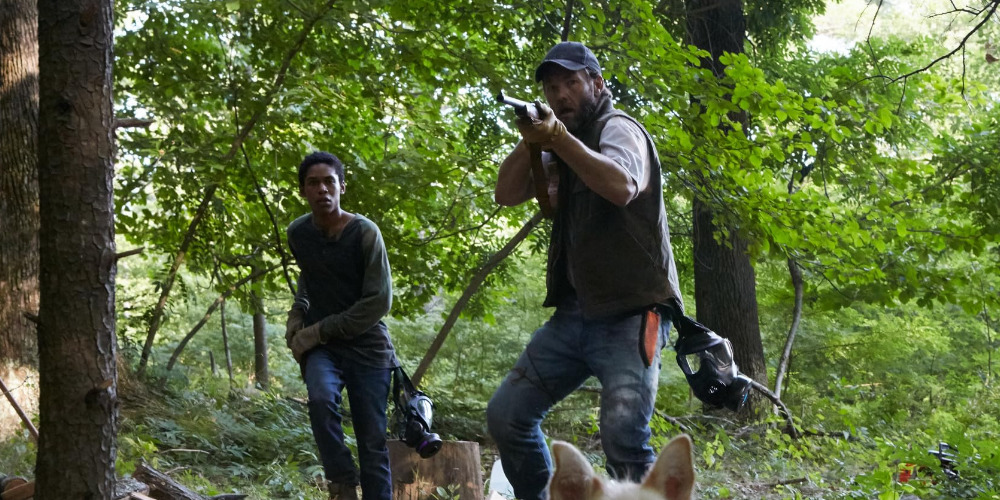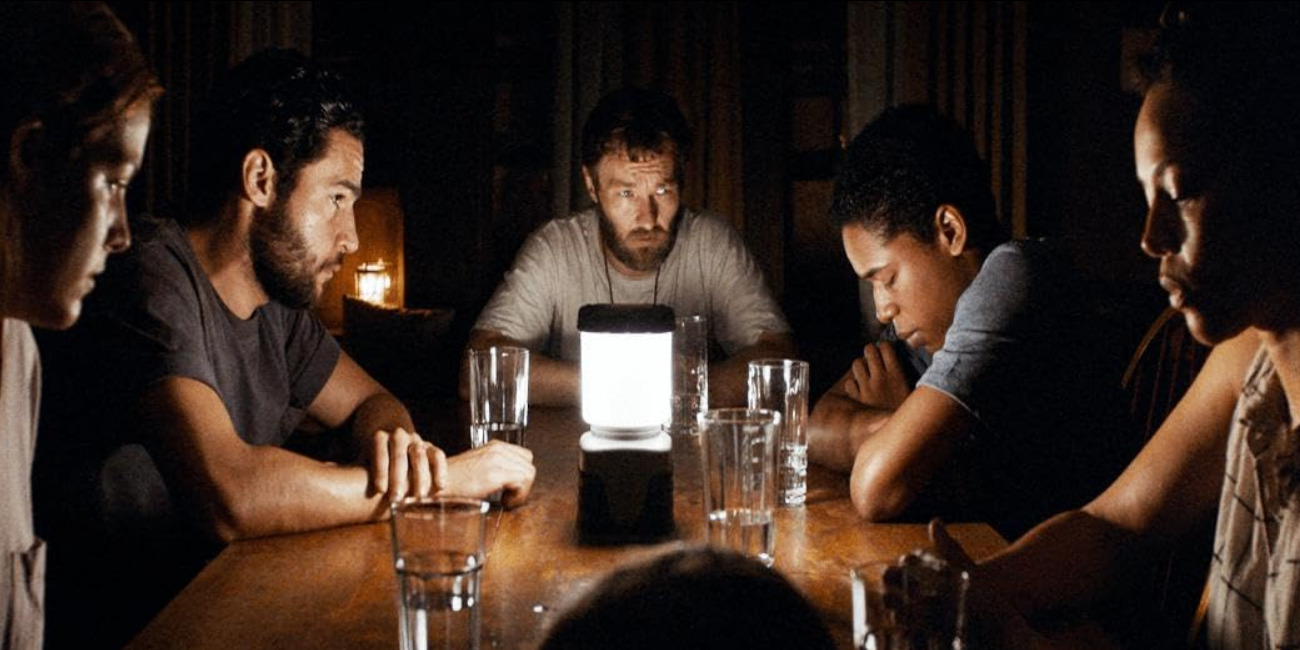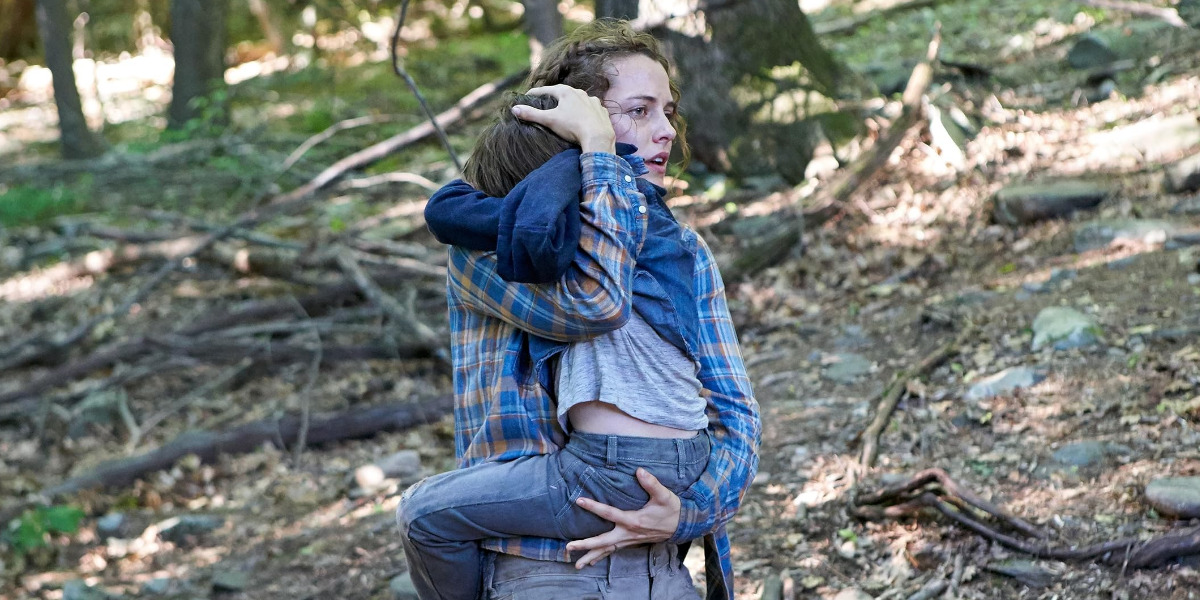‘It Comes At Night,’ the 2017 horror film, initially comes across as a survival story of two families against an unnamed plague and an unseen monster. While the outside world deteriorates into of-screen chaos, the narrative focuses on Paul, Sarah, and Travis, a normal family made abnormal by their circumstances. Under Paul’s guidance and rules, his family plays by strict rules to ensure no one contracts the deadly sickness plaguing the world. Moreover, when someone does, they dutifully lay them to a kinder death with a bullet and a burned corpse. As such, the arrival of a new family, Will and Kim, with their toddler, Andrew, introduces a different perspective for Paul’s family.
Nevertheless, given the contagious nature of the sickness and the inherent distrust that comes with a one-track focus on self-preservation, the tension between Paul and Will’s family grows, threatening their safety more than any outside danger could. Yet, the question remains: what exactly lies in the forest bushels and the infected individual’s sickening air that drives these two families to such drastic measures? Better yet, who really is the monster within the film’s narrative? SPOILERS AHEAD!
The Mysterious Sickness and Its Outcomes
Within the textual narrative, ‘It Comes At Night’ provides no explicit explanation about the titular “it” that presumably comes out at night. Through conversations between the characters, the audience learns that there is some increased danger present outside in the woods at night. For the same reason, Paul has strict rules against setting foot outside of the boarded house after nightfall. Whatever threat lies on the outside in the dark is well-known enough by the rest of Paul’s family— and Will’s by the time they become a part of the ecosystem in Paul’s house— that no one contests this rule.

Yet, the characters are so good at playing by this one specific rule that no one ever ventures into the outside at night, effectively robbing the narrative of a chance to showcase the threat outside. Therefore, the audience can only theorize about the possible dangers that are hiding in the dark.
Within all its ambiguity, one of the things that the narrative makes clear is the deadly nature of the mysterious sickness. The film opens with a shot of Bud, Sarah’s father, and Travis’ grandfather on his death bed, splotchy with black patches of skin and soulless eyes. Whatever the sickness is, it has infected Bud and has started to overtake his body. However, instead of attempting to save her father or allowing him to live out his last few days surrounded by family, Sarah embraces the finality of her father’s demise.
Later, Paul and Travis carry Bud’s body out to the yard, where Paul shoots the old man and buries his body in a grave. As a final nail in the coffin, they burn Bud’s body, ensuring every trace of him is gone. From Bud’s death, we can infer a few things.
First, Bud’s isolation while he’s sick, Paul and Travis’ safety masks, and the man’s removal from the house imply that whatever Bud had, it is contagious. Furthermore, since the family immediately accepts that they have no choice but to kill the man, the sickness is likely incurable and leads to a painful death. As such, death by a bullet, even if fired by his own son-in-law, is kinder for Bud than allowing the sickness to take him.
While these facts only suggest the sickness’ plague-like nature, there is one final clue that associates a more menacing idea to the ordeal. Instead of simply letting Bud’s body decompose in the ground, Paul and his family choose to burn it. Although this could be another result of hypervigilance, it’s also possible that Paul burns Bud because he’d rather not face what becomes of the latter’s infected dead body.
Thus, the idea emerges that the sickness is really just a prelude to the victim’s transformation into something more deadly. The most obvious destination this path of thinking leads to is the ever-infamous undead creatures: Zombies. The existence of zombies would explain why Paul and the others are afraid of going out in the dark.
Furthermore, it would give a name to the creature that attacks Stanley, the dog, toward the film’s end. Even though the film never confirms or denies this theory, it lends a corporeal identity to the ever-present horror within the story, allowing context for the characters’ predicaments.
Travis’ Nightmares and The Monster Within
The other, more ambiguous reading of the film’s narrative comes from the understanding that the real monsters reside within the characters. The film is solely interested in exploring the story unfolding within the house’s walls. Thus, it remains uninterested in crafting an explanation for the horrors that lie outside of the same.

Paul believes that as long as he and his family stay inside their safe house, the sickness and the pain in the outside world won’t be able to touch them. For the same reason, he comes up with rules and abides by them as the law. Nonetheless, although Paul’s family is relatively safe at the film’s start, they aren’t happy. Paul and Sarah are drifting apart, engaging in tense conversations, and Travis is overwhelmed by his new brutal reality. They are a safe family, but nothing’s holding them together.
Consequently, it isn’t until Paul is ready to bend his rules a little and allow Will and his family shelter in his house that things begin to change. The mood lightens around the house, and Travis’ family becomes a unit again. The two families slowly and steadily gravitate toward one another through dinner conversation and candlelit game nights.
Still, Paul’s paranoia persists. He remains on guard as if in an attempt to catch Will out in his lies. Despite their camaraderie and friendship, Paul can never fully trust Will since he’s an outsider. The post-apocalyptic world has made Paul so cynical he can’t think of anything outside him and his family. As such, when one drop of the outside evil bleeds into their house, in the form of Stanley’s death and an inexplicably open red door, the peace between the families immediately crumbles.
In order for Paul to believe Andrew isn’t infected, the man has to blindly trust Will, who’s already running on hope and luck. Furthermore, he would have to accept that if Andrew isn’t infected, Travis must be since someone has to have opened the door. Therefore, Paul has no choice but to go against Will’s family since the alternative goes against everything he has taught himself about this new world.
As a result, Paul chooses to believe Andrew is infected and ends up killing the kid and his parents in cold blood with Sarah’s help. Such an act of blatant cruelty showcases the darkness that resides within Paul and his family as a result of their circumstances. The sickness has compelled them to believe in such a selfish way of life they have become jaded. For the same reason, they have been robbed of at least a part of their humanity.
In the end, Paul and Sarah must contemplate the same when Travis falls victim to the sickness despite their best efforts. Neither can ever truly know if Travis got infected by Andrew or if he was patient zero. Similarly, neither does the audience. Due to his cryptic dreams that border on reality before turning into a manifestation of Travis’ anxieties, his character remains an unreliable narrator throughout the film.
Therefore, the audience, like Travis’ parents, can’t know for sure if the kid opened the red door in search of his dog and brought him back to the house while sleepwalking. Although the idea has many things working against it, the implication is enough to instill a chilling doubt about every character’s morality.
However, this film relies entirely upon implication. The implication of Will and his family coincidentally finding Paul’s cabin when Bud’s pyre sent out a smoke signal. The implication of Andrew and Travis’ potential sleepwalking habits. They’re the primal source of distrust that grows into suspicion and paranoia, the true crux of the film’s horror. As such, through a more thematic interpretation of the film, one can conclude that the monster in ‘It Comes At Night’ is the evil doubt residing within every character that prevents them from trusting and caring for their fellow human beings.
Read More: FUBAR Season 2 to be Shot in Toronto; Pre-Production Starts Next Month


